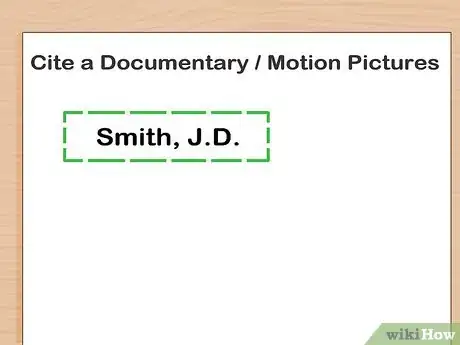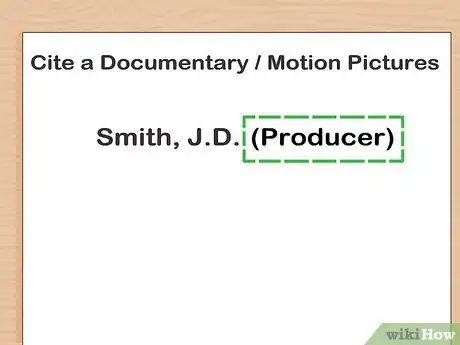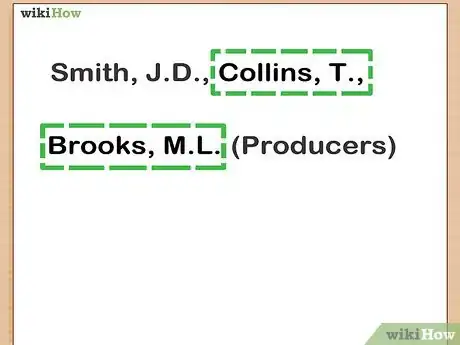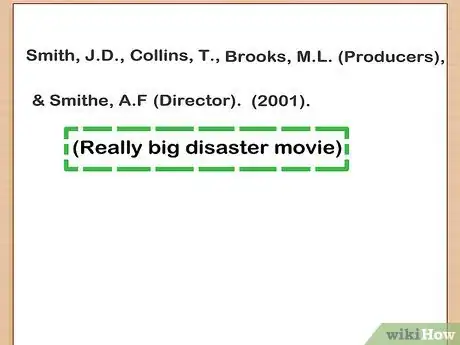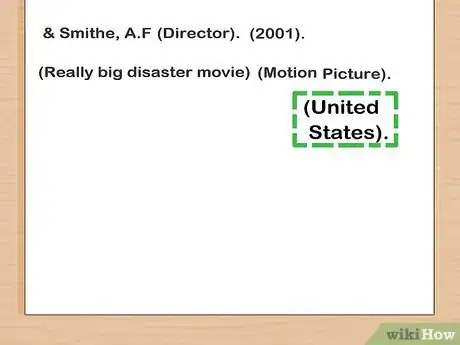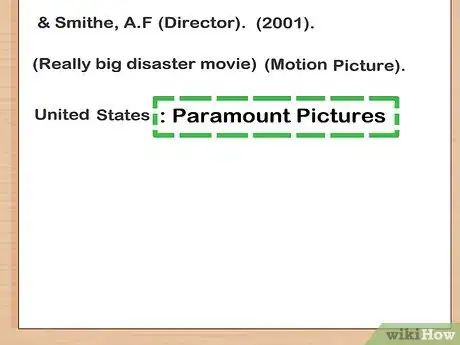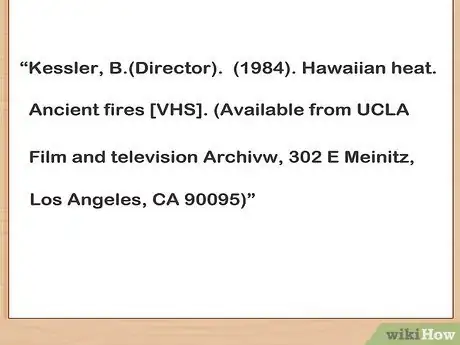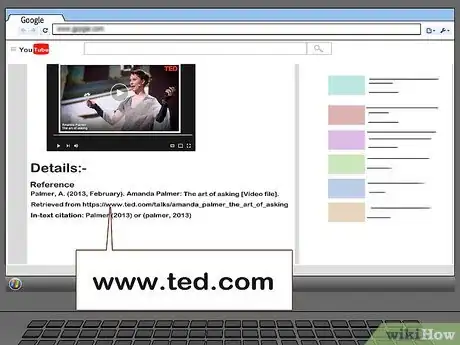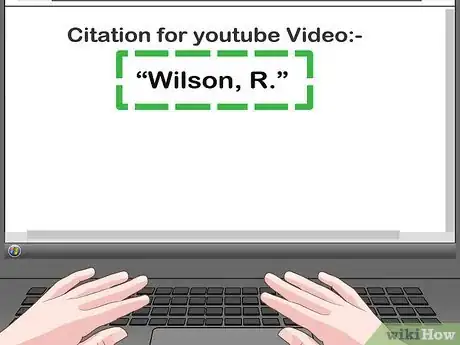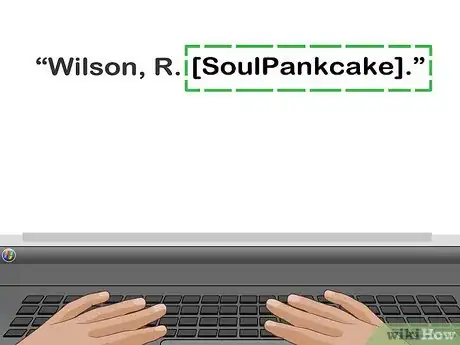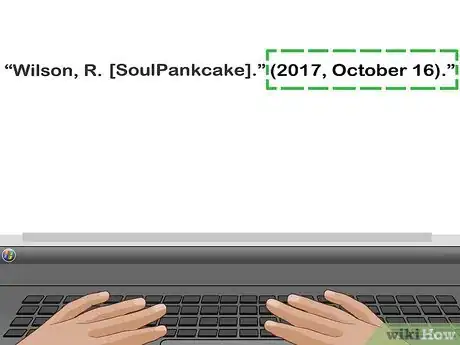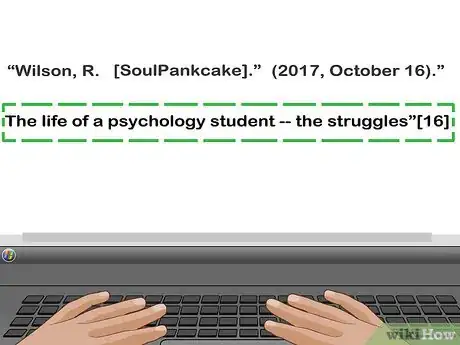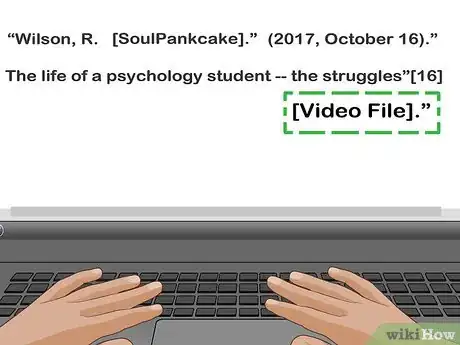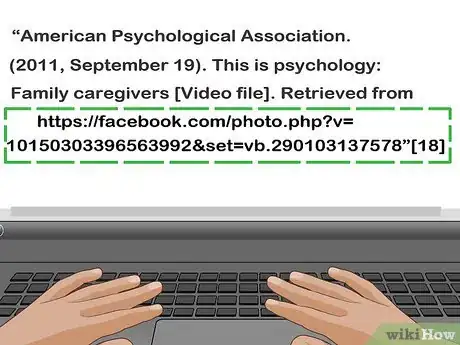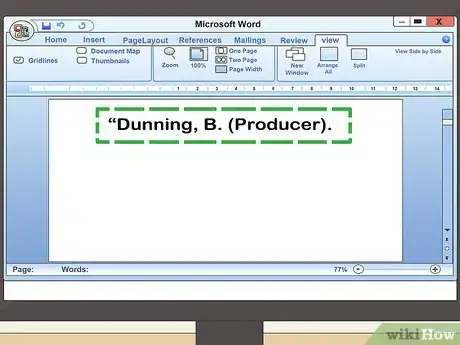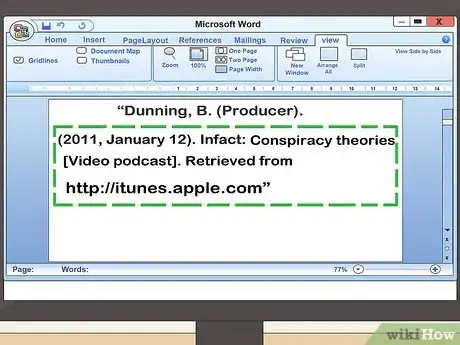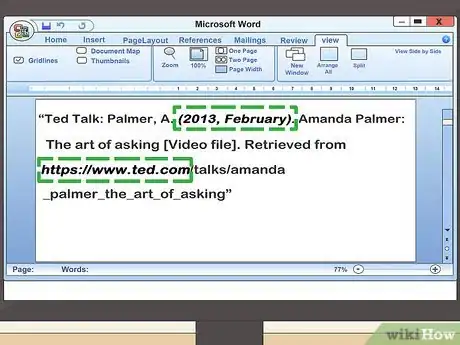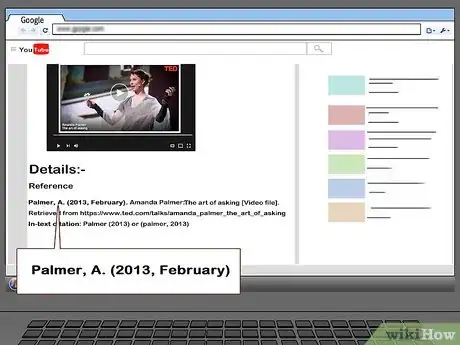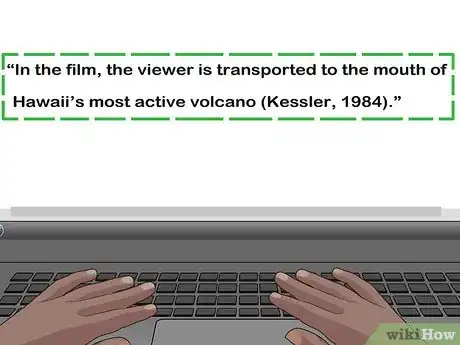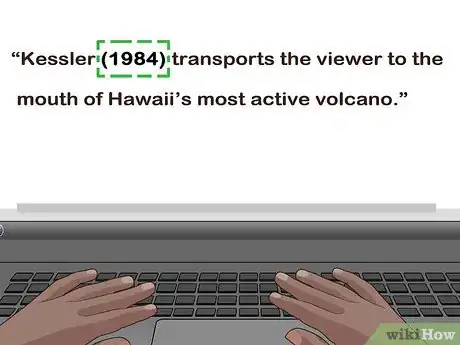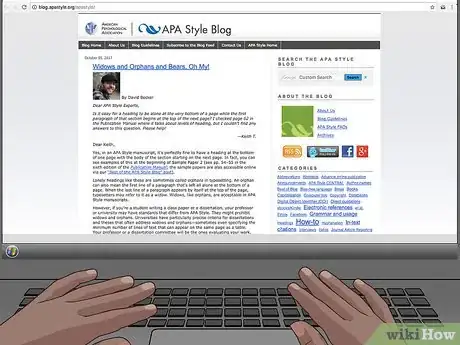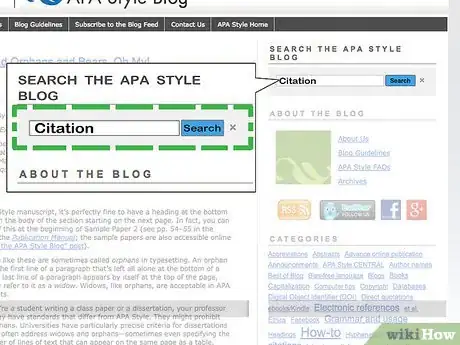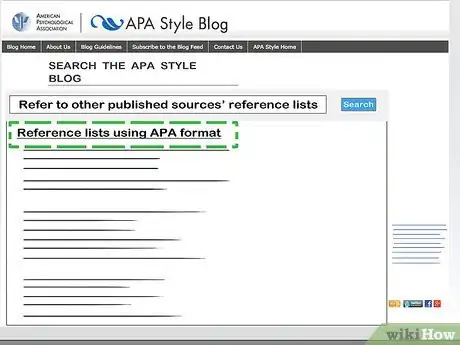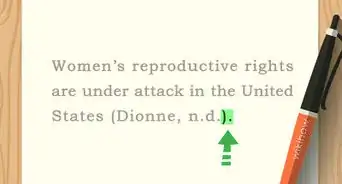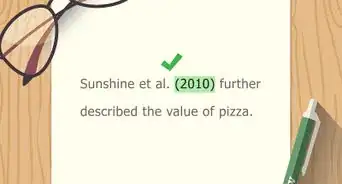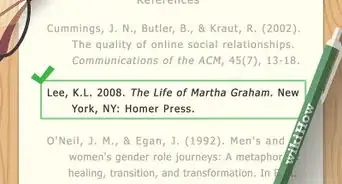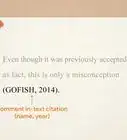This article was co-authored by wikiHow Staff. Our trained team of editors and researchers validate articles for accuracy and comprehensiveness. wikiHow's Content Management Team carefully monitors the work from our editorial staff to ensure that each article is backed by trusted research and meets our high quality standards.
There are 11 references cited in this article, which can be found at the bottom of the page.
This article has been viewed 32,849 times.
Learn more...
Video source material can enrich your research. Even though citing videos may seem tricky at times, the American Psychological Association (APA) has formulated clear guidelines for citing video material.[1] All you have to do is identify what type of video you are using and follow the rules for citing that type of video. Once you master the process, you’ll be ready to draw from an ever-growing wealth of video material for your research.
Steps
Documentaries and Motion Pictures
-
1Begin with the producer’s name. Write the producer’s last name followed by a comma. Then write the producer’s first initial followed by a period and their middle initial (if they have one) followed by a period.[2]
- For example, you should write: “Smith, J.D.”
-
2Add the producer’s title after their name. Write “Producer” after the producer’s name. Always capitalize the title, put it in parentheses, and add a comma after it.[3]
- Your citation should look like this: “Smith, J.D. (Producer),”
Advertisement -
3List all producers’ names if the video has more than one. Especially with major motion pictures, you’ll often find that multiple people produced the film. Follow the same format as with the first producer for each individual name. Separate each producer’s name with a comma and put “and” in front of the last producer’s name. Write, “Producers” in parentheses at the end of the list and conclude with a comma.[4]
- You’ll want to use this format: “Smith, J.D., Collins, T., and Brooks, M. L. (Producers),”
-
4Write the director’s name after listing the producer(s). After “(Producer),” write “&” and then write the director’s last name followed by a comma. Write the director’s first initial before a period and then their middle initial followed by a period. Write “Director” in parentheses after the director’s name and follow it with a period.[5]
- For example, you should write: “Smith, J.D., Collins, T., and Brooks, M. L. (Producers), & Smithee, A. F. (Director).”
-
5Add the release date for the film. You only need to include the year for this date. Put it in parentheses and follow it with a period.[6]
- It should follow a format that looks like this: “Smith, J.D., Collins, T., and Brooks, M. L. (Producers), & Smithee, A. F. (Director). (2001).”
-
6Write out the title of the film. Make sure to italicize the film's title. Only capitalize the first letter of the title, any proper nouns, and the first letter after a colon if the title contains one. Do not add punctuation at the end of the title.[7]
- Your citation will appear in this format: “Smith, J.D., Collins, T., and Brooks, M. L. (Producers), & Smithee, A. F. (Director). (2001). Really big disaster movie”
-
7Classify the type of video cited. After the title, indicate the film type. Put this information inside brackets and follow with a period.
- Use “[Motion picture]” to indicate a major motion picture. You can use this designation even you watched it online or if the movie is available on DVD. It should look like this: “Smith, J.D., Collins, T., and Brooks, M. L. (Producers), & Smithee, A. F. (Director). (2001). Really big disaster movie [Motion picture].”
- Add “[DVD]” or [VHS] if a film, such as a documentary, is available in either format. Even if you personally viewed the film online, you should cite this format if the same version is available on DVD or VHS. Your citation should look like this: “Spurlock, M. (2004). Super size me [DVD].”[8]
-
8Note the country of origin. Include the country of origin after the video type. Write out the entire country name and follow it with a colon. The country of origin refers to where production company has its headquarters.
- You can find this information at the bottom of a movie poster or online at sites like IMDb. For rare or historic films, search WorldCat: http://www.worldcat.org/
- For example, you’ll want to write: “Smith, J.D., Collins, T., and Brooks, M. L. (Producers), & Smithee, A. F. (Director). (2001). Really big disaster movie [Motion picture]. United States:”
-
9Include the production company’s information. After the country of origin, write the production company. End with a period.[9]
- A full citation should look like this: “Smith, J.D., Collins, T., and Brooks, M. L. (Producers), & Smithee, A. F. (Director). (2001). Really big disaster movie [Motion picture]. United States: Paramount Pictures.”
-
10Indicate when a film is not widely available. Older films might be archived and hard to find. On the other hand, newer films or films with limited distribution, may only be found online. If the film you cite is not available in theaters, DVD, or VHS, then you’ll need to add additional information.[10]
- For rare or archived movies, include the address where you viewed it: “Kessler, B. (Director). (1984). Hawaiian heat. Ancient fires [VHS]. (Available from UCLA Film and television Archive, 302 E Meinitz, Los Angeles, CA 90095)”
- For films that can only be found online, follow the instructions for streaming videos below.
YouTube and Other Streaming Videos
-
1Find the original video before citing. Many videos posted on YouTube, Vimeo, and social medial cites like Facebook get reposted frequently. You don’t want to credit the wrong person, so take time to track down the original video.[11]
- The original video usually has the highest number of views.
- Click on the creator’s user name to view some of the other posts on their channel or profile. Browse through these videos to determine if the channel belongs to the person who posted the video you want to cite.
-
2Begin your citation with the creator’s name. You want to write their last name first followed by a comma. After the comma, write the first initial of their first name followed by a period. If the author has a middle name, add the first letter of their name middle name and add another period.[12]
- If an individual posted the video, it should look like this: “Wilson, R.”
- When organizations like BBC News, the American Psychological Association, and Cambridge University post videos relevant to your research, cite the organization’s title as the creator: “BBC News.”
- Always try to locate the creator's real name rather than relying on their user name. Sometimes you will not be able to find the creator’s real name. If this happens, skip this step.
-
3Include the user name in your citation. If you know don’t know the individual’s full name, then capitalize the first letter of the user name and start your citation with it. If you do know the user’s full name, the user name will come after the full name inside brackets. Always add a period after the user name.[13]
- When you don’t know the creator’s full name, write the user name like this: “Bellofoletti.”
- When you do know the creator’s full name, write it this way: “Wilson, R. [SoulPankcake].”
- You can find the user name (or channel name) on YouTube and Vimeo by looking underneath the view count on the left side of the screen. On Facebook, the user name (or profile name) is found in the upper left next to the picture.
-
4Write the date that the video was posted. Put the date in parentheses after the user name. Write the date in this order: put the year, add a comma, write the month, add a comma, then write the day of the month. Put a period after the end of the parenthesis.[14]
- For example, you’ll want to write: “Wilson, R. [SoulPankcake]. (2017, October 16).”
-
5Write the full video title after the date. Capitalize the first letter of the title as well as any proper nouns and the first letter that commons after a colon if the title contains one. Italicize the title for all videos excepts video blogs. Do not add a period at the end of the title.[15]
- Do not italicize the title for video blog (or vlog) posts even if hosted on YouTube or other platforms:” Oladunni, L. [Lizzie Oladunni]. (2016, November 6). The life of a psychology student -- the struggles”[16]
- Do italicize the title for all other hosted videos: “Psychology Tomorrow. (2015, March 26). The body language documentary”
-
6Put the file type after the title. Write “Video File” in brackets, and put it after the title. Make sure “Video” and “File” are always capitalized.[17]
- For example, you should write: “Oladunni, L. [Lizzie Oladunni]. (2016, November 6). The life of a psychology student -- the struggles [Video File].”
-
7Provide the URL to link to the video. After “[Video File],” write “Retrieved from” and then paste the URL for the video. To find a video’s URL, click on the share button on your host site. Copy the URL and then paste it into your document to ensure that it’s accurate. Never add a period after the URL.
- Your citation should look something like this: “American Psychological Association. (2011, September 19). This is psychology: Family caregivers [Video file]. Retrieved from https://facebook.com/photo.php?v=10150303396563992&set=vb.290103137578”[18]
Unique Formats for Podcasts, Webinars, and Lectures
-
1Start a video podcast's citation with the creator’s name and role. Write the creator’s last name first and then add a comma, the creator's first initial, a period, the creator's middle initial, and another period. Write “Producer” in parentheses after the creator's name and add a period after the parentheses.
- You’ll want to follow a format that looks like this: “Dunning, B. (Producer).
-
2Add the video podcast's date, title, format, and location to your citation. Write the date in parentheses—including the year, month, and day—and end with a period after the parentheses. Add the podcast's full title with only the first letter, proper nouns, and the first word after a colon capitalized. Write, “Video podcast” inside brackets--making sure “Video” is capitalized, “podcast” is not capitalized, and a period comes after the brackets. End with “Retrieved from” and the podcast's URL[19]
- When your citation is complete, it should look like this: “Dunning, B. (Producer). (2011, January 12). Infact: Conspiracy theories [Video podcast]. Retrieved from http://itunes.apple.com”
-
3Use a specialized format for Ted Talks. Write “Ted Talk” and follow it with a colon before writing the speaker’s name. Even if you originally view a Ted Talk on a hosted site like YouTube, cite the original from the Ted Talk website. For Ted Talks, you do not need to include the day it was posted—only the month and year.[20]
- For example, you should write: “Ted Talk: Palmer, A. (2013, February). Amanda Palmer: The art of asking [Video file]. Retrieved from https://www.ted.com/talks/amanda_palmer_the_art_of_asking”
-
4Cite webinars with a specialized format. Webinar citations begin with the capitalized producer’s name followed by a period. Next write “(Producer)” and follow it with another period. Put the year the content was produced in parentheses and another period. Then italicize the full title of the program. Write “[Webinar]” after the title. Conclude with “Retrieved from” and then the full URL.[21]
- For example, you’ll want to write: “American Psychological Association. (Producer). (2017). Basics of APA style: An online course [Webinar]. Retrieved from http://www.apa.org/education/ce/4210701.aspx”
Adding in-Text Citations
-
1Identify a video’s date and its creators’ surnames for in-text citations. For your in-text citation, you need to know the year the video was produced or posted online. You will not need to include the month or day of the month. You’ll also need to know the creators’ surnames—including both producers and directors.[22]
- For a video with one producer or creator, you’ll only need that person’s surname.
- For a video with a producer and a director, you will need to list both—always putting the producer’s name first.
- For a YouTube video, you will just use the creator’s last name and leave out the user name. However, if you do not know the creator’s last name, then you will use the user name instead.
-
2Put citations at the end of sentences that don't mention the creator. When your text does not specifically reference a director or producer by name, you'll need to include the creator's name in your in-text citation. Write the creator’s surname followed by a comma. Then write the date of production. Put this information in parentheses before the period at the end the sentence.[23]
- For a single creator, it will look like this: “In the film, the viewer is transported to the mouth of Hawaii’s most active volcano (Kessler, 1984).”
- For more than one creator, the citation will look this way: “Never before had anthropologists questioned the truth-claims of their own culture. (Monroe & Harper, 1989).”
-
3Put the date after the creator’s surname when it's used in a sentence. When the video creator’s last name is used organically in your writing, all you have to do is put the video's production date after it. Make sure the date is in parenthesis.[24]
- Your in-text citation should look like this: “Kessler (1984) transports the viewer to the mouth of Hawaii’s most active volcano.”
- If your video has two creators, it will look this way: “Monroe and Harper (1989) reveal the revolutionary elements of early twentieth century anthropology.”
Consulting Additional Resources for Exceptions
-
1Visit the APA Style Blog for information about unique citations. Sometimes you come across a video that doesn’t fit any of the standard citation cases. Or a new video platform may have been recently released, and you may not know how to cite videos from it. The APA Style Blog addresses these issues on a regular a basis, so visit their website for more information: http://blog.apastyle.org/apastyle/
- Enter your question into their website’s search field to explore archived posts. Chances are someone else has already asked your question.
-
2Ask an expert for help with a unique citation. If you can’t find the answer to your question, ask an expert. Librarians are excellent resources. Or you can post your own question for an APA Style Expert to answer on the APA Style Blog.[25]
-
3Refer to other published sources’ reference lists. Find a published article or book that uses APA format and cites a range of video sources. Look at how they cited similar cases.
- Make sure you use published sources only because unpublished sources may not be accurate.
- If you know that someone else has cited the same video, you can even find the exact citation you need.
Warnings
- Don’t get the APA style confused with MLA or Chicago styles. They all have different standards.⧼thumbs_response⧽
- Watch out for streaming sources that may not be around in the future. You want to avoid linking to sources that will disappear or a link that will be broken when your readers try to check your source material.⧼thumbs_response⧽
References
- ↑ http://www.apastyle.org/manual/introduction.pdf
- ↑ https://owl.english.purdue.edu/owl/resource/560/11/
- ↑ http://libguides.gwumc.edu/c.php?g=27779&p=170347
- ↑ https://valenciacollege.edu/library/mla-apa-chicago-guides/documents/VideoAPA6.pdf
- ↑ http://libguides.gwumc.edu/c.php?g=27779&p=170347
- ↑ https://owl.english.purdue.edu/owl/resource/560/11/
- ↑ https://owl.english.purdue.edu/owl/resource/560/11/
- ↑ http://libguides.gwumc.edu/c.php?g=27779&p=170347
- ↑ https://owl.english.purdue.edu/owl/resource/560/11/
- ↑ https://owl.english.purdue.edu/owl/resource/560/11/
- ↑ http://blog.apastyle.org/apastyle/electronic-references/
- ↑ http://www.apastyle.org/learn/quick-guide-on-references.aspx
- ↑ http://blog.apastyle.org/apastyle/electronic-references/
- ↑ http://www.apastyle.org/learn/quick-guide-on-references.aspx
- ↑ http://blog.apastyle.org/apastyle/electronic-references/
- ↑ https://owl.english.purdue.edu/owl/resource/560/10/
- ↑ http://www.apastyle.org/learn/quick-guide-on-references.aspx
- ↑ http://blog.apastyle.org/apastyle/social-media/
- ↑ http://blog.apastyle.org/apastyle/social-media/
- ↑ http://blog.apastyle.org/apastyle/social-media/
- ↑ http://academicanswers.waldenu.edu/faq/72706
- ↑ http://libguides.gwumc.edu/c.php?g=27779&p=170347
- ↑ https://owl.english.purdue.edu/owl/resource/560/11/
- ↑ https://owl.english.purdue.edu/owl/resource/560/11/
- ↑ http://blog.apastyle.org/apastyle/social-media/
About This Article
To cite a YouTube or other streaming video in APA, start by writing the original creator's last name, followed by a comma and their first initial. Then, add the creator's username in brackets, followed by a period. Next, write the date in parentheses, with the year first, followed by the month and day. After that, write the full video title, followed by "Video File" in brackets. Finally, write "Retrieved From," followed by the URL to the video. To learn how to cite a documentary or motion picture in APA, read on!
